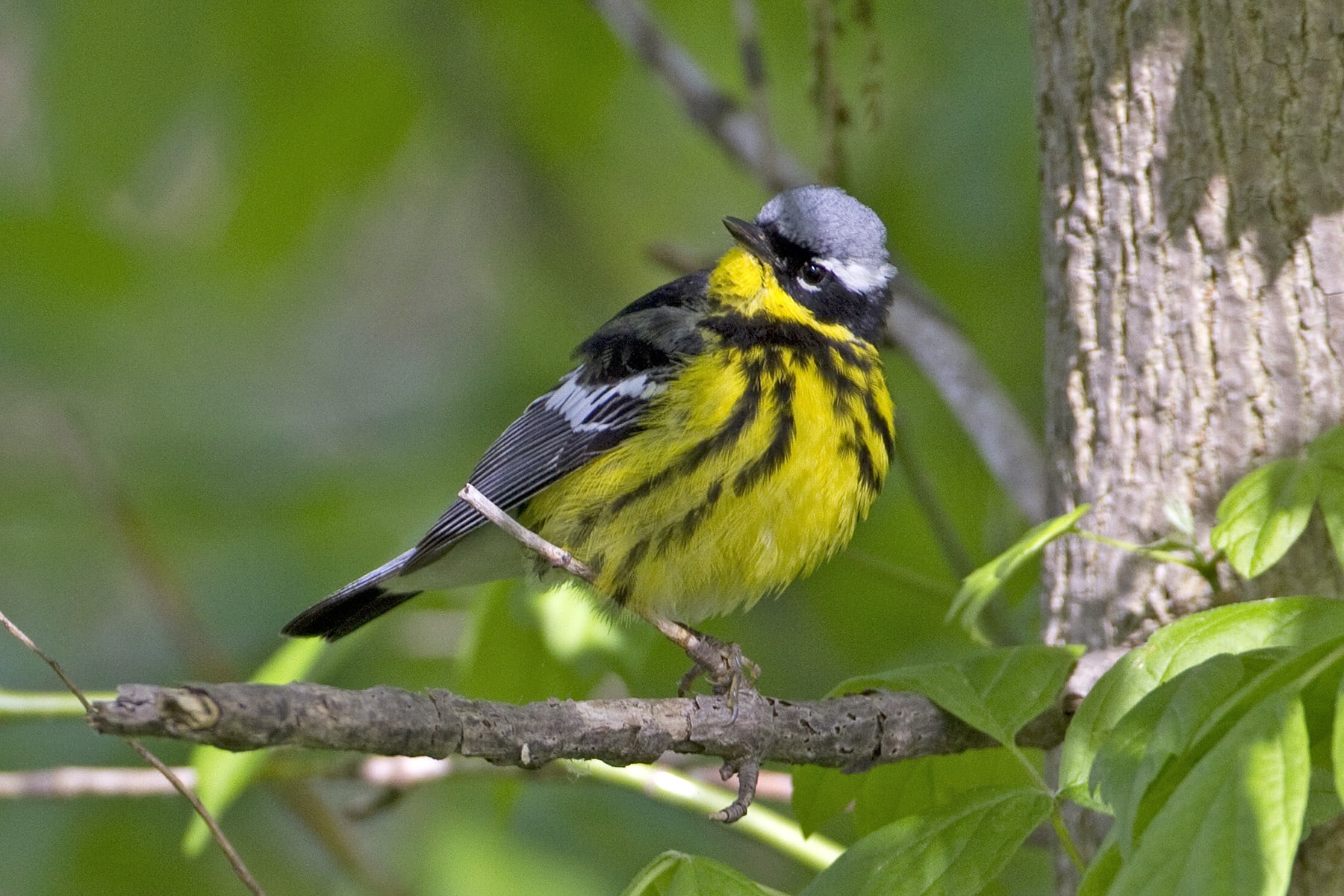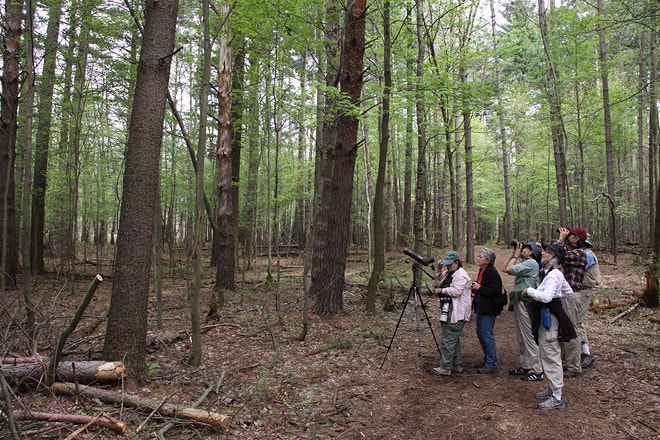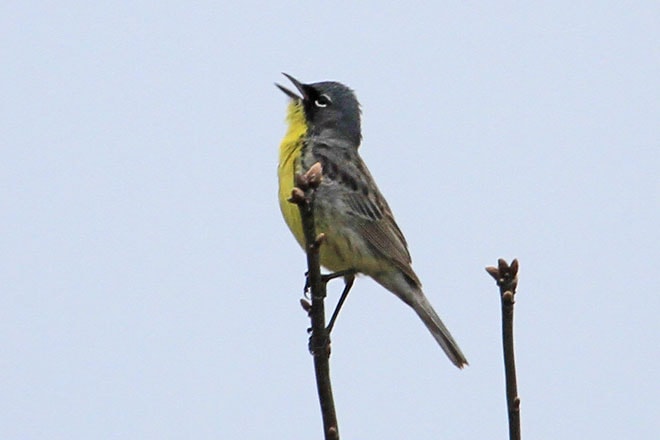TRIP REPORT: OHIO & MICHIGAN – 2011 May – Magee Marsh & Kirtland’s Warbler

TOUR FOCUS
TRIP LEADERS
PRIVATE TOUR OPTION
This tour is available as a private trip for any size group. The tour cost will vary with the number of people and any custom requests.
TESTIMONIALS
Trip report by Adrian Binns

Cape May Warbler
Members of San Diego Audubon Society joined me for two back-to-back, week-long trips in May 2011, to enjoy the so-called ‘Warbler Capital of the World,” on the shores of Lake Erie in the Northwestern region of Ohio. We journeyed here to witness the wonderful spectacle of spring migration, and experience “The Biggest Week in American Birding,” an annual event hosted by Black Swamp Bird Observatory, and were not disappointed!

Ottawa National Wildlife Refuge
The first trip, May 8-14, centered around Magee Marsh Wildlife Area and Ottawa National Wildlife Refuge, with outings to Metzger Marsh Wildlife Area, Oak Openings, and Maumee Bay State Park. The second trip, May 14-20, covered these same areas, but also included an overnight stay in northern Michigan to see Kirtlandʼs Warbler in its breeding habitat.
On both trips, we spent nearly every morning at Magee Marsh, walking slowly along an elevated boardwalk that meanders through a deciduous wood forest. Here, many of the birds come so close you can almost touch them, and we enjoyed excellent views of great numbers of warblers flitting about, often at eye-level. Each morning brought something new and exciting for us to admire.

Prothonotary Warbler
Yellow-rumped “Myrtle” Warblers dominated the scene during the first trip, but decreased in number as the month progressed. Northern Parula, American Redstart, Ovenbird, Nashville, Magnolia, Palm, Yellow, Chestnut-sided and Black- throated Green Warblers were abundant. Black-and-White, Black-throated Blue, Blackpoll and a few Pine Warblers showed well.
Prothonotary Warblers, local breeders in these wet woods, sang from their perch just a few feet away. Canada, Cape May, Wilsonʼs, Mourning, Tennessee and Orange-crowned Warblers drew ample appreciation from onlookers. Eye-catching Bay-breasted and Blackburnian Warblers brought excitement at nearly every turn.
During our first trip we got word about a Cerulean Warbler and hurried over to look at what was a life bird for many people. If was one of the few birds that we had to look into the canopy to see, but we all got great looks at this male. Northern Waterthrushes bobbed along marshy edges, crossing paths with many female Red-winged Blackbirds that were tossing leaves. Phil, from our first group, was excited to see his only life bird of the trip, a Connecticut Warbler. Unfortunately, that species and Hooded Warbler were missed by the second group.

American Woodcock
Warblers were not the only birds to capture our attention during this spectacle of Spring migration. American Woodcocks caused a flurry of excitement each day they were spotted probing in the mud, their earth-toned plumages blended nearly perfectly with surrounding foliage. Surprisingly, we encountered a woodcock crossing the road early one morning, much to the delight of Peter and the 2nd group.
Numerous thrushes moved through the ground and understory, including Veery, Wood, Swainsonʼs and Gray-cheeked Thrushes. Hermit Thrushes were seen only by the first group; these early migrants had left the area by mid-May. Lincolnʼs and White-throated Sparrows joined the blackbirds in scratching the leaf-litter. Flashy Scarlet Tanagers, Rose-breasted Grosbeaks and Baltimore Orioles moved gracefully through the canopy. We found Yellow-billed and Black-billed Cuckoos, along with both Golden- crowned and Ruby-crowned Kinglets.
The first group enjoyed two pleasantly unexpected surprises at Magee Marsh. Someoneʼs sharp eyes spotted a roosting Eastern Whip-poor-will very well-camouflaged in the ground tangles, and hundreds of people came to enjoy this oft-heard but rarely seen species. A lively Winter Wren was seen moving furtively along the marshy edges around the same time.
Everyone lined-up at the scope to admire a sleeping, gray-morph Eastern Screech-Owl tucked in a snag quite close to the boardwalk. This bird often changed his roosting site. There was also a red-morph peeking out of a nest box.

Warbling Vireo
We found 5 species of vireos on each trip. Red-eyed, Blue-headed, ubiquitous Warbling, and a handful of Philadelphia Vireos were readily seen by all; the first group added Yellow-throated, while the second group got White-eyed Vireo.
There were many sightings of flycatchers all showing well. The common ones included Least Flycatcher, Eastern Phoebe, Eastern Wood-Pewee and Eastern Kingbird, while Willow Flycatchers became more numerous as the month went on. Several non-calling Willow/Alder went on the list as ʻTrailʼs.ʼ Acadian and Olive-sided were seen by the first group and we all got excellent views of several Yellow- bellied Flycatchers.
We supported various local businesses for lunch, including the popular Blackberry Corners. The Barnside Creamery and other ice-cream parlors were also happy to see us, as we couldnʼt resist a daily stop to treat ourselves with assorted sundaes and shakes, thanks to Richard! We spent afternoons exploring other birding hotspots.
Bald Eagles were nesting in several places, with numerous sightings of adults and juveniles soaring overhead on nicer days. We found American Pipit, Horned Lark, Savannah Sparrow, and Bobolink in farm fields. American Kestrel and Eastern Bluebird perched predictably on wires. Several wet areas hosted Black-bellied Plovers, Semipalmated Plovers, Least Sandpipers, yellowlegs and Dunlin.
The Ottawa National Wildlife Refuge, adjacent to Magee Marsh, spans thousands of acres of marshland, ponds, woods and fields, providing important habitat for breeding and migratory birds. We toured the refuge auto-loop and walked the woods behind the visitor center, finding Yellow-headed Blackbirds, Marsh Wren,
Swamp Sparrow, Ring-necked Duck, Red-breasted Merganser and much more. Ottawa highlights for the first group included Blue-winged and Golden-winged Warblers, Acadian Flycatcher and Black Tern. The second group experienced ʻwalking with warblers,ʼ with many birds surrounding us at head height or lower.


Red-headed Woodpecker
Oak Openings Preserve, part of Toledoʼs public Metropark system, encompasses over 3,700 acres of unique and diverse habitat, attracting naturalists, researchers and birders to study itʼs rich wildlife. Here we enjoyed some wonderful birds, including Grasshopper, Savannah, Field and Chipping Sparrows, Eastern Meadowlark (feeding young during the second trip), amongst the more open grasslands. Part of the preserve is managed specifically for an isolated population of Lark Sparrows which breed here well east of their typical range. The scrub and forest edge yielded Orchard Oriole, Eastern Towhee, and Indigo Bunting while Red-headed Woodpeckers noisily worked along areas of open woods. The first group found Acadian Flycatcher, and the second group got Summer Tanager, Blue Grosbeak and a calling Pileated Woodpecker.
Outings to Maumee Bay proved pleasantly productive to both groups, for different reasons. This large state park offers recreational boating, swimming and resort facilities, but we focused on the nature center boardwalk winding through woods and swamp. The first group found a perched juvenile Broad-winged Hawk, Olive-sided Flycatcher, and a nice assortment of warblers. The second group saw Brown Creeper, Swainsonʼs and Gray-cheeked Thrushes, and side-by-side views of Caspian and Common Terns on the beach. The latter folks also studied a Trailʼs flycatcher (Willow/Alder), unable to determine the species since it didnʼt sing.
At Metzger Marsh, we searched unsuccessfully for the reported Little Blue Heron, but found Red-breasted Nuthatch, American Coot, Northern Harrier, Ruddy Ducks, Pied-billed Grebes and several Bald Eagles standing together in the marsh.

Gary-cheeked Thrush (front) and Veery (back)
Part of the “Biggest Week in American Birding” included a presentation by Kenn Kaufman, “Understanding what you see for better bird ID.” The first group enjoyed his talk and meeting Kenn afterwards. We were also extremely fortunate for the special opportunity to spend a few hours at a local banding station on May 13, as invited guests of Kim Kaufman. It was a major highlight to witness a huge variety of birds being processed in this top-notch operation, including a dozen warbler species, side-by-side comparisons of male and female Bay-breasted Warbler, size comparison between Gary-cheeked Thrush and Veery, and a Connecticut Warbler proudly presented by Mark, the master bander.

In addition to all the wonderful avian species, we enjoyed myriad mammals, and a handful of reptiles, amphibians and butterflies.
Eastern Fox Squirrels were relatively common, and we saw several Raccoons in various, cute poses. Beaver and Muskrats moved through the marshes, and Midland Painted Turtles basked in the sun.
Our best butterflies were a Hoary Elfin and Dreamy Duskywing in Michigan.
Near the end of our second trip, May 19, we departed early in the morning for the drive north to Michigan. By late morning, we reached the Pine Haven Recreational area. We took a lovely walk around the open forest, finding Red-Eyed Vireos, Blue-gray Gnatcatchers, Scarlet Tanagers, Eastern Wood Pewee, Willow Flycatchers and a beautiful though brief look at a Yellow-bellied Sapsucker. After some time, Millie spotted a Cerulean Warbler over the path, at which we all got great looks!

King Rail
We drove east towards Saginaw Bay, located on the western edge of Lake Huron. By the time we reached Nayanquing it was drizzling steadily. Umbrellas in hand, we walked the dike roads into the marsh. Our efforts were rewarded with great sightings of Sora, Swamp Sparrow, a rare King Rail, Black Tern and Least Bittern in flight. Though it was mid-afternoon, we heard the deep pumping call of American Bittern!
Our last birding of the day occurred in Grayling, at Hartwick Pines Visitors Center, where we watched Evening Grosbeaks, Purple Finches, Black-capped Chickadees and Red-breasted Nuthatches coming into the feeders, where Eastern Chipmunk and Red Squirrel scampered about. We also saw a Hairy Woodpecker busy feeding young, and the Wild Turkey sighting rounded out a lovely day.
 Our final day of the trip began with a talk from Forest Service Staff, explaining about the life and habitat of the endangered Kirtlandʼs Warbler. We learned that Kirtlandʼs breeds specifically in Jack Pine trees that are 3-6 feet in height, with their outer boughs touching the ground. We followed our friendly guide to the precious habitat location, where we enjoyed stunning sightings of a singing Kirtlandʼs Warbler. Funnily enough, it was perched on a taller oak tree! We added Clay-colored and Vesper Sparrows to our list, heard numerous Nashville Warblers singing, and saw several Common Ravens soaring in the distance. We picked up Brewerʼs Blackbird along with Lincolnʼs, Field, Chipping, and Savannah Sparrows.
Our final day of the trip began with a talk from Forest Service Staff, explaining about the life and habitat of the endangered Kirtlandʼs Warbler. We learned that Kirtlandʼs breeds specifically in Jack Pine trees that are 3-6 feet in height, with their outer boughs touching the ground. We followed our friendly guide to the precious habitat location, where we enjoyed stunning sightings of a singing Kirtlandʼs Warbler. Funnily enough, it was perched on a taller oak tree! We added Clay-colored and Vesper Sparrows to our list, heard numerous Nashville Warblers singing, and saw several Common Ravens soaring in the distance. We picked up Brewerʼs Blackbird along with Lincolnʼs, Field, Chipping, and Savannah Sparrows.

Kirtland’s Warbler
After an early lunch, we headed back to Detroit Airport, with a brief detour to a meadow spot where we found Bobolink, Horned Larks, and our target Henslowʼs Sparrow – a delightful end to a marvelous trip!
A hearty thanks to everyone who truly made this the “Biggest Week(s) in American Birding!”
Trip Facts and Stats
Warblers peaked on May 13 with 26 species (though I got 27 species on May 6, a few days before the first group arrived). We enjoyed between 21 and 24 warbler species on all other days. The first trip, May 8-14, logged a total of 153 species including 30 warblers. The second trip, May 14-20, got 163 total species with 27 warblers, including Kirtlandʼs Warbler and other species found in Michigan only.
In general, early season migrants (1st week of May) in NW Ohio included Yellow-rumped, Palm, Black-and- white, Nashville, Black-throated Green and Northern Parula. The second wave (2nd week) saw increased numbers of Magnolia, Chestnut-sided, Bay-breasted and American Redstarts. The 3rd week of May saw an influx of Canada, Wilsonʼs, Blackpoll and Mourning Warbler. Connecticut Warbler is more likely nearer the end of the month, when flycatchers such as Olive-sided, Yellow-bellied, Willow and Alder push through. The early weeks of migration typically feature many adult males, while the latter part sees fewer adult males, more females and more first-year males.
The first group enjoyed warm temperatures (surprisingly into the 80ʼs) and sunshine. By contrast the second trip was overcast and cooler with a stalled low system over NW Ohio producing chilly northerly winds and scattered rain for the 4 full days that we had to bird there. These conditions forced the birds to forage low, and often quite close, allowing for extraordinary views.
Spring weather is highly variable, and differences in the species list of the two trips can be attributed in part to the weather systems which greatly impact migratory movements, as well as overall luck in our birding efforts.



